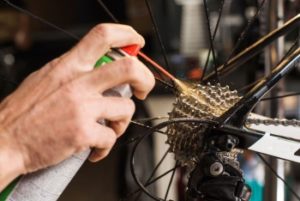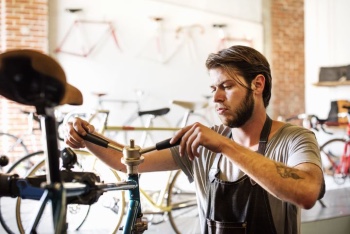
During the warmer months of the year, bicyclists of all ages can be found in both urban and rural areas enjoying the outdoors while getting exercise.
In many areas, people put their cars away and prefer taking a bike instead of taking a car.
However, if you’re like the average person, you put your bicycle in storage at the end of fall, and then leave it there until sometime in the middle of the spring season when it becomes warm enough for biking once again.
Due to those months of neglect, it is likely time to perform some routine maintenance on your bicycle. Incidentally, for the enterprising individual, bicycle maintenance can be a great way to make quick money in the warmer seasons of the year. So if you’re looking to pad your wallet, some knowledge about bicycle maintenance could be a valuable investment.
If you’re looking to perform some basic bicycle maintenance, it would be best that you don’t simply rely on a written guide, but rather spend some time learning the basic mechanics and function of a bicycle, perhaps using coursework from a distance learning school like Stratford Career Institute.
Maintaining A Bicycle
The basics of bike maintenance are not much unlike the basics of caring for your car or motorcycle. The first step is a thorough inspection.
Inspection
Before you take your bicycle out for the first spin of the year, it only makes sense that you should ensure it is in decent working condition. Obviously, the best time to find out that there’s an issue with your brakes or your chain is when you’re safely in your garage, driveway, or basement, rather than when you’re cruising down the street.
Many bike shops and bike mechanics suggest that you adhere to the ABC’s of inspection. That means checking the Air, Brakes, and Chain.
Air refers to the tires on your bicycle. If it’s been sitting in an area that lacks climate control, the air in your tires is at the mercy of the environment.
To check the tires, you first find out the appropriate pressure (usually, this information can be found on the side wall of the tires). Then, using an air gauge or a pump with a PSI gauge on it, you ensure that you have the recommended air pressure for your tire.
If you’re low, pump up the tires, and if you’re higher than the recommended limit (which would be extremely unusual), bleed a little bit out by using a pressure gauge or even a screwdriver.
While checking the pressure, ensure that your tires are securely fixed to the bike, and that any quick-release levers are properly tightened. Failing to do this can lead to the loss of a tire while in motion, which is a surefire recipe for a painful accident.
The ‘B’ in ABC refers to the brakes. Most bikes have both front and rear brakes, with each having a separate brake lever on the handlebar. Inspecting them is a simple process; simply squeeze each lever and ensure that the break is functioning properly, responsively, and that it is gripping the tire.
The ‘C’ in ABC is the bike chain, which is responsible for transferring motion from the pedals to the tire. The bike chain is what gives a bicycle its ‘go,’ and if it breaks, it not only robs the bike of a
Checking the bicycle chain is a pretty easy process, thankfully. You check for rust throughout and ensure that the chain is properly oiled, that the links are not rusted or in any other way showing signs of serious wear.
As a very general rule, if you perform this kind of inspection and the bicycle appears to be in functioning order, you are in the clear, and your bicycle is ready to ride without any worry about serious problems in the near future.
General Maintenance After Use
Any time that you use something as complex as a bicycle, there is going to be some sort of maintenance that occurs. For bicycles, the after-use maintenance is shockingly simple, thankfully.
Generally, this kind of after-use maintenance, barring some sort of catastrophic failure of the bicycle, is limited to simply ensuring that various crews and bolts are properly tightened, and that the bike chain is properly lubricated.
Tightening the various nuts, bolts, screws, and other parts of the bicycle is a simple process. One simply needs a variety of screwdrivers and wrenches, and to identify which (if any) of those nuts, bolts, and screws are loose.
Upkeep of the Bike Chain, Gear,
Some of the most important parts of the bicycle, and some of the parts most prone to damage (including outright breaking during use) of a bicycle are the bike chain, the gears, and the brakes.
Because they are mechanical parts that are grinding, rubbing, and rotating around the bicycle, it only makes sense that they will need cleaning, greasing, oiling, lubricating via other means, and perhaps even other forms of care.
A word of caution, however, concerning maintenance of a bicycle and its parts. Many novices think that spraying the bike with oil, or a compound like WD-40 (a useful general-purpose compound that can lubricate, protect, and even clean metal components), is a simple cure-all for any sort of issues concerning its operation.
Due to this misconception, some people think that all they have to do to protect the ‘moving’ parts of their bicycle is to liberally apply oil, WD-40, or some other sort of lubricant.
However, in truth, this is more likely to cause problems than to solve them. While lubricant applied to the bike chain and brakes, for example, may help the bicycle to run smoothly, it also attracts dirt, dust, and various other kinds of debris. This debris becomes attached to the lubricant, and can eventually become ‘baked’ or dried on.
If you live in an area where there’s a lot of salt and other treatments applied to the roads to prevent the accumulation of snow during the winter, over-application of lubricant can even speed up the process of corrosion of metal parts.
If you’re going to lubricate your car and its moving parts like the chain, brakes, gears, and even derailleur, you need to have a few tools.
Firstly, you will need some WD-40, some axle grease, and if you’re partial to it, some oil. While a course at Stratford Career Institute can give you specific brand names for your bicycle tune up, these are just good general items to have.
You will also want to have, near at hand, a few clean rags, a toothbrush, a degreasing agent (preferably, something other than turpentine or kerosene), some soap and water, and, perhaps most importantly, a bike stand to keep the bike immobile while the cleaning occurs.
After collecting your essential bike tools, the first thing to do to properly ‘tune up’ and lubricate your bicycle is to wipe any dirty components using a moist rag. If there is hard-to-reach dirt or grime building up on something like the bike chain, it may be worth bringing along a stiff (non-metal) toothbrush to help wipe away the more caked-on dirt.
Then comes the actual application of lubricants. The trick with applying lubricant is not to over-apply, and to wipe away all excess. Generally, if there is liquid lubricant dripping off of your bicycle, you have overdone it.
When it comes to axel grease, if there are huge globs of it, once again, you’ve overdone the application. If you’ve applied too much, just wipe off the excess, gently, cautiously, with a rag.
These are the basics of bicycle maintenance and upkeep. If you follow these simple instructions, you will manage to keep your bike in working shape, extend the lifespan of your bike chain, and ensure that the only reason you might fall is because you weren’t watching where you were peddling.
Explore a Career as a Bicycle Mechanic
If you’re looking to learn more, or just simply to have the concepts discussed here better explained, look into something like the courses offered by Stratford Career Institute. If you do so, you will be able to take better care of your bicycle, and maybe even learn enough to make a bit of money taking care of other people’s bikes.
Take the next step and enroll in Stratford’s bicycle mechanic course today!
Interested in a Bicycle Mechanic Career?

Learn more about a bicycle mechanic career by enrolling in Stratford Career Institute’s online course!



